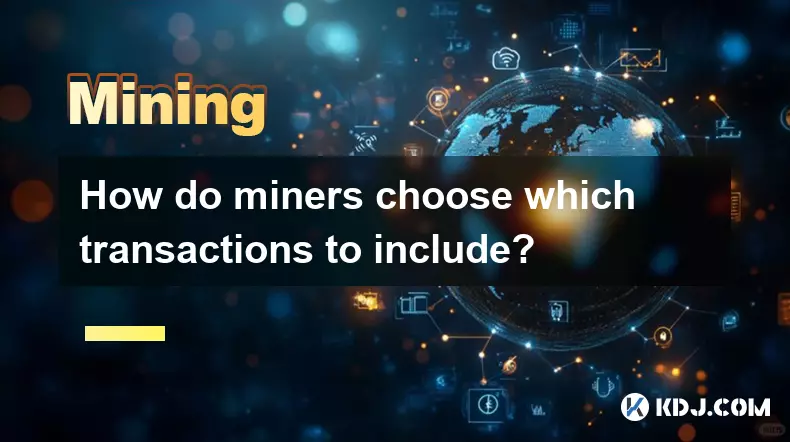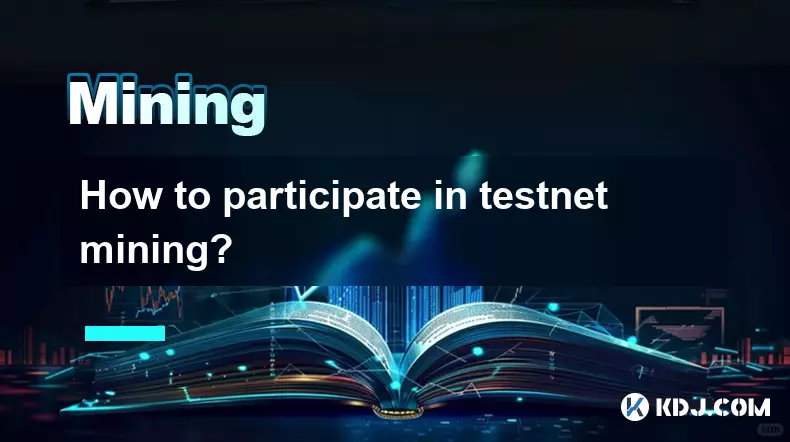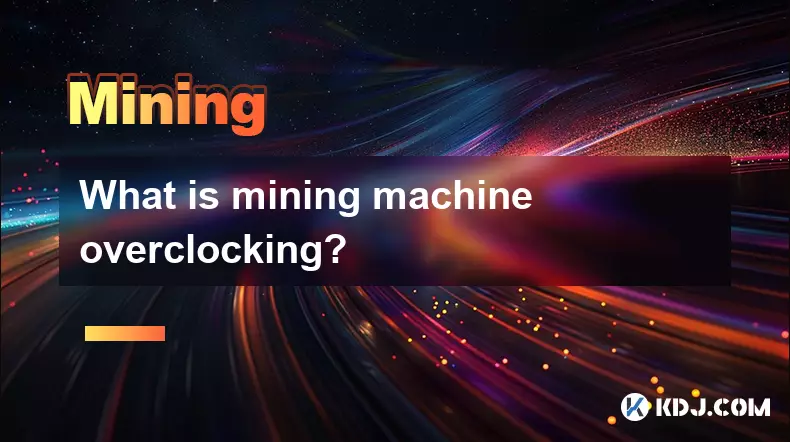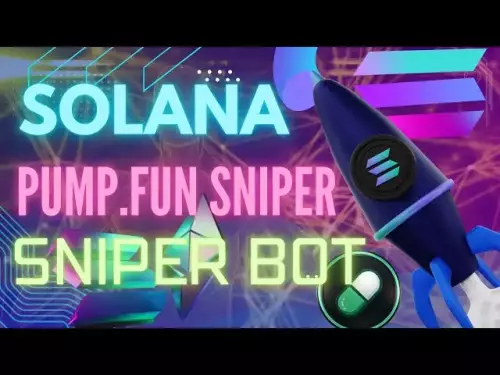-
 bitcoin
bitcoin $112195.049338 USD
2.42% -
 ethereum
ethereum $4124.915858 USD
2.81% -
 tether
tether $1.000570 USD
0.02% -
 xrp
xrp $2.861568 USD
2.25% -
 bnb
bnb $1000.346670 USD
3.04% -
 solana
solana $209.070819 USD
3.38% -
 usd-coin
usd-coin $0.999870 USD
0.02% -
 dogecoin
dogecoin $0.235379 USD
2.65% -
 tron
tron $0.335681 USD
-0.20% -
 cardano
cardano $0.803501 USD
3.38% -
 hyperliquid
hyperliquid $47.120881 USD
3.56% -
 chainlink
chainlink $21.501300 USD
3.44% -
 ethena-usde
ethena-usde $1.000571 USD
0.02% -
 avalanche
avalanche $29.793378 USD
3.62% -
 stellar
stellar $0.366964 USD
2.42%
How do miners choose which transactions to include?
Miners prioritize transactions with higher fees per byte to maximize profits, selecting from the mempool based on fee rates, block size limits, and network rules.
Sep 22, 2025 at 06:54 am

Understanding Transaction Selection in Cryptocurrency Mining
Miners play a critical role in maintaining blockchain networks by validating and including transactions into new blocks. Their selection process is driven by economic incentives, network rules, and technical constraints. The decision of which transactions to include is not arbitrary but follows specific patterns shaped by the design of the blockchain.
Fees as the Primary Incentive
1. Transactions with higher fees are prioritized over those with lower fees.Each transaction submitted to the network includes a fee paid to miners. This fee acts as compensation for the computational resources used to validate and secure the transaction. Miners aim to maximize their earnings per block, so they naturally select transactions offering the highest fees relative to their size.
2. Fee-per-byte or fee-per-weight-unit metrics guide inclusion decisions.
Block space is limited, especially on networks like Bitcoin where each block is capped at 1MB (or 4MWU after SegWit). To optimize profitability, miners sort pending transactions by fee rate—how much fee is paid per unit of data. A small transaction with a high fee will be included before a large one with a low fee, even if the total fee of the latter is slightly higher.
3. Dynamic mempool management influences miner behavior.
The mempool is a holding area for unconfirmed transactions. Miners continuously monitor this pool and update their candidate block with the most profitable combination of transactions. If network congestion increases, users often raise their fees through mechanisms like Replace-By-Fee (RBF), prompting miners to replace lower-paying transactions with updated, higher-paying versions.
4. Long-standing low-fee transactions may be dropped from consideration.
Some nodes and miners impose time-to-live limits on mempool entries. Transactions that remain unconfirmed for extended periods due to insufficient fees might be evicted from the mempool, effectively removing them from contention until rebroadcast with a higher fee.
5. Miner policies can vary based on software and operational strategy.
While most miners follow profit-maximizing logic, some mining pools may adopt different policies—for example, prioritizing certain types of transactions for ideological reasons or supporting specific protocols. However, such deviations are rare because they reduce competitiveness in the mining race.
Network Rules and Consensus Constraints
1. All selected transactions must be valid according to consensus rules.Before including any transaction, miners verify its digital signature, input availability, and compliance with script requirements. Invalid transactions are rejected regardless of the attached fee. This ensures the integrity of the blockchain and prevents double-spending attempts.
2. Chain of dependencies affects inclusion order.
In cases where a transaction spends outputs from another unconfirmed transaction (a child-pays-for-parent scenario), miners evaluate the combined fee rate of both. If including the parent enables a high-fee child transaction, it becomes economically rational to include both together, even if the parent alone has a low fee.
3. Block weight limits restrict the total number of transactions.
On Bitcoin, blocks are measured in virtual bytes (vB) or weight units (WU), with a maximum of 4 million WUs per block. Miners use algorithms to pack transactions efficiently within this limit, favoring combinations that yield the highest total fee without exceeding capacity.
4. Timestamp ordering must respect chronological consistency.
Although miners have discretion over transaction order, they must ensure that inputs are not spent before they exist. Transactions referencing unmined outputs cannot precede their parents in the block. This constraint shapes how miners structure the internal sequence of transactions.
5. Anti-DoS measures prevent spam inclusion.
Miners apply filters to avoid bloating blocks with low-value or malformed transactions designed to clog the network. Even if such transactions carry minimal fees, the cost of processing and propagating them may outweigh the benefit, leading miners to exclude them.
Strategic Behavior and Market Dynamics
1. Fee estimation tools help users compete for block space.Wallets and exchanges use real-time mempool analytics to suggest appropriate fees. When demand spikes, these tools recommend higher rates to ensure timely confirmation, indirectly shaping the pool of transactions available for miner selection.
2. Large transactions from exchanges often dominate blocks.
Crypto exchanges generate bulk payouts and withdrawals, contributing significantly to mempool volume. These entities typically set competitive fees to maintain service quality, making their transactions frequent candidates for inclusion.
3. Miner Extractable Value (MEV) introduces advanced selection strategies.
Though more prominent in Ethereum, MEV concepts are emerging in Bitcoin through techniques like time-bandit attacks or strategic reordering. Miners can extract additional value by manipulating transaction order, particularly around events like hash rate fluctuations or difficulty adjustments.
4. Centralized mining pools exert influence over global transaction flow.
A handful of large mining pools control substantial portions of network hash power. Their collective policies shape overall transaction throughput and confirmation times, creating de facto standards for fee markets across the ecosystem.
5. Competition among miners enforces efficiency.
If a miner consistently leaves high-fee transactions out of blocks, they risk falling behind competitors who capture more revenue per block. This competitive pressure ensures that fee optimization remains a core operational focus across the mining industry.
Frequently Asked Questions
Can miners include zero-fee transactions?Yes, but only under specific conditions. Some miners include zero-fee transactions if they originate from trusted sources, are part of promotional campaigns, or help fill otherwise unused block space during low-demand periods. However, this is uncommon during congestion.
Do all miners use the same algorithm to pick transactions?No. While most follow a greedy approach maximizing fees per byte, implementation details vary. Some miners use custom scripts or support CPFP clustering, while others integrate advanced packing algorithms to squeeze more value out of limited block space.
What happens to transactions that aren’t included in a block?They remain in the mempool and stay eligible for future blocks. As long as the sender doesn’t cancel or replace them, nodes continue broadcasting them until a miner includes them or they expire due to age or mempool limits.
Can a transaction be excluded for non-economic reasons?Technically yes. A miner could blacklist certain addresses or transaction types, though doing so reduces profitability and is discouraged by the decentralized nature of the network. Most miners prioritize economic gain over censorship due to competitive pressures.
Disclaimer:info@kdj.com
The information provided is not trading advice. kdj.com does not assume any responsibility for any investments made based on the information provided in this article. Cryptocurrencies are highly volatile and it is highly recommended that you invest with caution after thorough research!
If you believe that the content used on this website infringes your copyright, please contact us immediately (info@kdj.com) and we will delete it promptly.
- SWIFT, Consensys, and Blockchain Settlement: A New Era for Global Finance?
- 2025-09-30 06:25:13
- Andre Cronje's Flying Tulip Takes Flight with $200M Round: A New Era for DeFi?
- 2025-09-30 06:45:14
- SEC, CFTC, and Crypto Rumors: Harmonization Efforts and ETF Developments
- 2025-09-30 06:45:14
- Gold Dollar Coin, Mystery, Upright 5: Unearthing Hidden History and Whale-Sized Speculation
- 2025-09-30 06:25:13
- Meme Coins, Smart Money, 2025 Riches: Navigating the Hype
- 2025-09-30 06:30:01
- Racist Meme Coins, PumpFun, and the Ecosystem: A Toxic Trend?
- 2025-09-30 06:50:01
Related knowledge

The difference between staking and mining
Sep 24,2025 at 05:18am
Understanding Staking in the Cryptocurrency Ecosystem1. Staking involves holding funds in a cryptocurrency wallet to support the operations of a block...

How to participate in testnet mining?
Sep 22,2025 at 09:18am
Understanding Testnet Mining in the Crypto Ecosystem1. Testnet mining is a method used by blockchain developers to simulate real-world conditions on a...

How to dispose of abandoned mining machines?
Sep 19,2025 at 08:19pm
Assessing the Condition of Abandoned Mining Rigs1. Begin by inspecting each mining machine for visible damage, corrosion, or missing components. Machi...

How to identify high-quality mining pools?
Sep 21,2025 at 03:19pm
Reputation and Track Record1. A mining pool’s reputation is built over time through consistent performance and transparency. Pools that have operated ...

Advantages of decentralized mining pools
Sep 20,2025 at 04:36pm
Enhanced Security and Resistance to Censorship1. Decentralized mining pools operate on blockchain-based smart contracts, eliminating the need for a ce...

What is mining machine overclocking?
Sep 21,2025 at 07:19pm
Understanding Mining Machine Overclocking1. Mining machine overclocking refers to the process of increasing the operating frequency of a cryptocurrenc...

The difference between staking and mining
Sep 24,2025 at 05:18am
Understanding Staking in the Cryptocurrency Ecosystem1. Staking involves holding funds in a cryptocurrency wallet to support the operations of a block...

How to participate in testnet mining?
Sep 22,2025 at 09:18am
Understanding Testnet Mining in the Crypto Ecosystem1. Testnet mining is a method used by blockchain developers to simulate real-world conditions on a...

How to dispose of abandoned mining machines?
Sep 19,2025 at 08:19pm
Assessing the Condition of Abandoned Mining Rigs1. Begin by inspecting each mining machine for visible damage, corrosion, or missing components. Machi...

How to identify high-quality mining pools?
Sep 21,2025 at 03:19pm
Reputation and Track Record1. A mining pool’s reputation is built over time through consistent performance and transparency. Pools that have operated ...

Advantages of decentralized mining pools
Sep 20,2025 at 04:36pm
Enhanced Security and Resistance to Censorship1. Decentralized mining pools operate on blockchain-based smart contracts, eliminating the need for a ce...

What is mining machine overclocking?
Sep 21,2025 at 07:19pm
Understanding Mining Machine Overclocking1. Mining machine overclocking refers to the process of increasing the operating frequency of a cryptocurrenc...
See all articles


























![[Pycoin] PI Coin -Shocking Listance of Pycoin?! 'Rebellion' This time ... Pay attention to #paikoin [Pycoin] PI Coin -Shocking Listance of Pycoin?! 'Rebellion' This time ... Pay attention to #paikoin](/uploads/2025/09/29/cryptocurrencies-news/videos/pycoin-pi-coin-shocking-listance-pycoin-rebellion-time-pay-attention-paikoin/68da82f23cec1_image_500_375.webp)















































